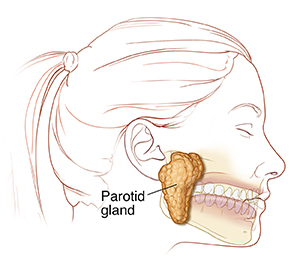Parotid duct obstruction is when part of your parotid duct becomes blocked. The parotid ducts are 2 small tubes that lead from the parotid glands, which make saliva. They carry the saliva into your mouth. When it’s blocked, saliva can’t flow normally.
How the saliva gland system works
The parotid gland is one of the salivary glands. The glands make saliva, the watery substance used to moisten your mouth and start the digestion process. The parotid gland sits at the back of your lower jaw in front of your ear. From there, saliva travels through a tube called the parotid duct. The saliva drains from the end of the duct and into your mouth.
Your salivary glands start to make saliva when you’re eating. If the parotid duct is blocked, the saliva can start to back up into the parotid gland. This can cause pain and swelling. In some cases, the gland and duct can become infected.
What causes parotid duct obstruction?
Parotid duct obstruction is most often caused by salivary gland stones. These are tiny stones made of calcium and other minerals. You’re more likely to have salivary gland stones if you:
-
Have an infection in the parotid gland
-
Don’t have enough water in your body (dehydration)
-
Have been taking water pills (diuretic medicine)
-
Have taken anticholinergic medicine, such as atropine
-
Have had injury to the duct or injury to that area of your face
-
Have gout
-
Have smoked or still smoke
Other things that can cause parotid duct obstruction include:
-
Scar tissue
-
Mucous plugs
-
Abnormal growth of cells
Symptoms of parotid duct obstruction
Symptoms can include pain and swelling near the back of the jaw. Some people have only swelling or only pain. Symptoms may often come and go. They are often worse during eating, when the salivary gland makes more saliva.
Sometimes an object only blocks the parotid duct off and on. If this is the case, you may go without symptoms for days or weeks.
If your gland stays blocked for a long time, it may stop making saliva. When that happens, your parotid gland might feel hard, but it may no longer be painful or swollen.
Diagnosing parotid duct obstruction
Your healthcare provider will ask about your health history. And they will perform a physical exam. This will include an exam of the inside of your mouth. Your healthcare provider may touch the skin over your parotid gland to see if it’s sore. In some cases, the stone may be felt during the exam.
In some cases, you may need imaging tests to help view the gland and look for other disorders (infection, swelling, and other problems) or blockages (stones). You may have tests such as:
-
CT scan. This uses a series of X-rays and a computer to make detailed images of the body.
-
X-rays. Small amounts of radiation create images of your organs and other structures inside your body.
-
Ultrasound. This uses sound waves and a computer to make images of tissue and organs in your body.
-
Sialography. These are X-rays of your salivary gland. They are done after the healthcare provider gives you a special dye to visualize the parotid duct. Other types of conditions may also be diagnosed, other than stones.


